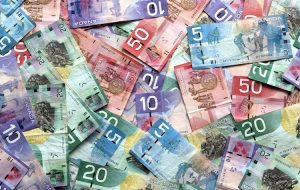Canadian Dollar easing back as Crude Oil pressures wane
Share: Canadian Dollar is easing off the pressure as Crude Oil prices soften. Canada economic data remains thin for the week, US data dominating the market. US inflation data to remain key market driver for the back half of the trading week. The Canadian Dollar (CAD) is stepping back slightly on Wednesday, giving

- Canadian Dollar is easing off the pressure as Crude Oil prices soften.
- Canada economic data remains thin for the week, US data dominating the market.
- US inflation data to remain key market driver for the back half of the trading week.
The Canadian Dollar (CAD) is stepping back slightly on Wednesday, giving the US Dollar (USD) some breathing room and sending the USD/CAD back into near-term highs.
Inflation expectations remain the pivotal market focus for this week, and with Canada-based data almost entirely absent on the economic calendar, chart direction will be determined by market reaction to US inflation figures through the rest of the week.
The USD/CAD has slipped back into yesterday’s highs as the Greenback catches a soft bid on data beats, and the Loonie is following softening Crude Oil prices slightly lower.
Daily Digest Market Movers: Canadian Dollar giving a pause in lockstep with barrel prices
- Bidding pressure for the CAD is abating, sending the USD/CAD pair back to Tuesday’s highs.
- Canadian economic data is almost entirely absent, save for low-impact data.
- Canada Building Permits for August managed a beat, printing at 3.4% versus the forecast 0.5%.
- Previous reading on Building Permits was revised down significantly, from -1.5% to -3.8%.
- Crude Oil prices are softening further, fading back the early week’s bid spike following the weekend’s Gaza Strip escalation between Israel and Palestinian Hamas.
- US data on Wednesday beat forecasts across the board.
- US Producer Price Index (PPI) for the year into September climbed to 2.7%, beating the 2.3% expectations. The previous reading was revised to 2.5% from 2.2%.
- US Consumer Price Index (CPI) inflation reading due on Thursday, will be significant, and likely to impact broad-market risk sentiment.
Technical Analysis: Canadian Dollar loosening its grip enough for the USD/CAD to reclaim 1.36 handle
Wednesday’s bounce in the USD/CAD sends the pair back into the upper bound of the previous day’s highs, trading above the 1.3600 handle with daily candlesticks set to catch technical support from the 50-day Simple Moving Average (SMA) near 1.3550 with the 200-day SMA sitting just north of 1.3450.
The USD/CAD got knocked down nearly 1.6% peak-to-trough from last week’s swing high into 1.3785, with the Canadian Dollar catching a Crude Oil-fueled bid. Downside pressure has eased off for the time being, but markets are awaiting a firmer read on US inflation data before plunging too far into either side of the USD.
Inflation FAQs
Inflation measures the rise in the price of a representative basket of goods and services. Headline inflation is usually expressed as a percentage change on a month-on-month (MoM) and year-on-year (YoY) basis. Core inflation excludes more volatile elements such as food and fuel which can fluctuate because of geopolitical and seasonal factors. Core inflation is the figure economists focus on and is the level targeted by central banks, which are mandated to keep inflation at a manageable level, usually around 2%.
The Consumer Price Index (CPI) measures the change in prices of a basket of goods and services over a period of time. It is usually expressed as a percentage change on a month-on-month (MoM) and year-on-year (YoY) basis. Core CPI is the figure targeted by central banks as it excludes volatile food and fuel inputs. When Core CPI rises above 2% it usually results in higher interest rates and vice versa when it falls below 2%. Since higher interest rates are positive for a currency, higher inflation usually results in a stronger currency. The opposite is true when inflation falls.
Although it may seem counter-intuitive, high inflation in a country pushes up the value of its currency and vice versa for lower inflation. This is because the central bank will normally raise interest rates to combat the higher inflation, which attract more global capital inflows from investors looking for a lucrative place to park their money.
Formerly, Gold was the asset investors turned to in times of high inflation because it preserved its value, and whilst investors will often still buy Gold for its safe-haven properties in times of extreme market turmoil, this is not the case most of the time. This is because when inflation is high, central banks will put up interest rates to combat it.
Higher interest rates are negative for Gold because they increase the opportunity-cost of holding Gold vis-a-vis an interest-bearing asset or placing the money in a cash deposit account. On the flipside, lower inflation tends to be positive for Gold as it brings interest rates down, making the bright metal a more viable investment alternative.
| آموزش مجازی مدیریت عالی حرفه ای کسب و کار Post DBA + مدرک معتبر قابل ترجمه رسمی با مهر دادگستری و وزارت امور خارجه |  آموزش مجازی مدیریت عالی و حرفه ای کسب و کار DBA آموزش مجازی مدیریت عالی و حرفه ای کسب و کار DBA+ مدرک معتبر قابل ترجمه رسمی با مهر دادگستری و وزارت امور خارجه |  آموزش مجازی مدیریت کسب و کار MBA آموزش مجازی مدیریت کسب و کار MBA+ مدرک معتبر قابل ترجمه رسمی با مهر دادگستری و وزارت امور خارجه |
 مدیریت حرفه ای کافی شاپ |  حقوقدان خبره |  سرآشپز حرفه ای |
 آموزش مجازی تعمیرات موبایل آموزش مجازی تعمیرات موبایل |  آموزش مجازی ICDL مهارت های رایانه کار درجه یک و دو |  آموزش مجازی کارشناس معاملات املاک_ مشاور املاک آموزش مجازی کارشناس معاملات املاک_ مشاور املاک |
- نظرات ارسال شده توسط شما، پس از تایید توسط مدیران سایت منتشر خواهد شد.
- نظراتی که حاوی تهمت یا افترا باشد منتشر نخواهد شد.
- نظراتی که به غیر از زبان فارسی یا غیر مرتبط با خبر باشد منتشر نخواهد شد.





ارسال نظر شما
مجموع نظرات : 0 در انتظار بررسی : 0 انتشار یافته : ۰